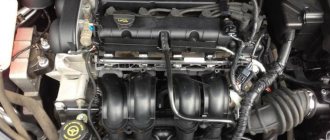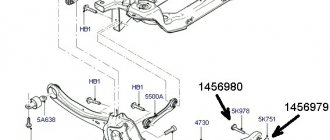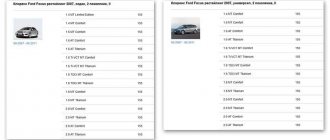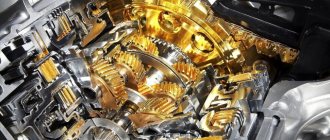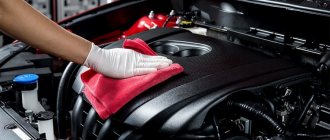The Ford Focus 2 car in its restyled and pre-restyling versions is still in great demand. It was sold in huge quantities and is still in demand on the secondary market.
But many car owners still don’t know that the car hides many pleasant surprises that are not described in the owner’s manual. As a result, 9 out of 10 owners do not use them.
Below we will look at what secret capabilities the vehicle has and how to activate them correctly.
We will talk about connecting the Scandinavian light, activating the automatic locking function, turning off the seat belt signal, etc.
Let us immediately note that some features may not work depending on what version the car is, when and where it was produced.
Automatic locking
The essence of the function is that after the movement begins, the locks on the doors automatically close, which prevents their accidental opening.
Many cars already have this option from the factory, but some Ford Focus 2 do not have it.
To activate, follow these steps:
- Insert the key into the lock and turn on the ignition.
- Open and close the doors three times using the button.
- Turn off the ignition.
- Open and close the doors again in the same way three times.
- Turn on the ignition and wait for a short signal to appear.
- Open and close the doors. The appearance of a long sound indicates that the work was performed correctly.
- Turn off the ignition.
After this, try driving the car and make sure that the locks automatically close.
This option is especially useful when traveling with children in the back seat, who may be playing and accidentally open the doors.
Manual for automatic transmission
The automatic transmission selector is the main control element of the automatic transmission. The following symbols are usually located on the automatic transmission selector:
P – Parking mode. The box is blocked.
N – Neutral, the car’s wheels are not blocked, engine torque is not supplied to them.
D(D3) – Normal forward movement with all gears changed sequentially.
S(L2,2,D2) – Low gear mode. In extreme conditions, this is a forced transmission reset and engine braking. If winter mode is not provided, then S will be its analogue.
L(D1) – Driving in first gear only. You can't drive in this gear for a long time, much less fast. The gearbox and motor will quickly overheat, fail and require repairs.
Overdrive – Prohibition of switching the next gear. Required for overtaking.
Power/Sport – Automatic transmission mode, when gears are changed at higher engine speeds.
ECO – Economy mode.
Winter/Snow – driving mode on slippery surfaces (sand, snow, ice), the car will start from 2-3 gears, making it easier to overcome obstacles. Especially relevant for winter conditions.
Block – Unlock button (can be in the form of a key) for changing gears without a key in the ignition switch. Necessary for towing a car after an accident or breakdown.
Scandinavian light
New cars are increasingly equipped with Scandinavian light, which means the headlights automatically turn on.
This function is convenient, but Ford Fox 2 does not provide it. Although, in the restyled and a number of other versions you can activate it manually.
To work you need to collect:
- a set of keys;
- 4-pin relay (for example, from VAZ 98.3747);
- pliers;
- wires;
- fuses for current 10 and 20 A;
- connectors.
Once the tool is prepared, proceed to activate the option.
Do the following:
- Disconnect the terminals from the battery to avoid accidental short circuit.
- Open the cover of the fuse box, which is located under the glove box on the right.
- In place of relay R15 we put 3747.
- In sockets 135 and 113 (in the diagram below) we install fuses of 20A and 10A, respectively.
- Between pins 1 and 26 we throw a short jumper.
- Attach the connectors to the wire and place everything in the block, including the relay.
- Close the unit cover and connect the terminals to the battery.
1 of 4
— +
1.
2.
3.
4.
After this, make sure that there is a Scandinavian light on the Ford Focus 2. If the headlights work, then the job is done correctly.
If it’s difficult, you can contact an auto electrician; many are already experienced in this matter and will do everything quickly and efficiently.
Common automatic transmission problems
One of the frequent breakdowns encountered on Focus models is the loss of 3-4 gears. As a rule, this malfunction occurs after 100,000 km. In this case, you should check the condition of the coupling. When it breaks, the clutches burn out. The coupling needs to be replaced. A major overhaul of the automatic transmission on a Ford Focus 2 is required if the torque converter has lost its properties.
If shocks appear when you decrease and increase speed, and you lose control of the car, it is advisable to check the quality of the fluid poured into the gearbox and the brake chain.
Automatic transmission repair Focus is relevant in the following cases:
If the clutches burn out, there may be a shortage of oil in the gearbox. One of the signs of this breakdown is the automatic transmission kicking.
The Ford Focus 2 automatic transmission control unit may lose its functions due to temperature changes. Overheating of the motor has a negative effect on rubber cuffs and o-rings.
You can eliminate jerking when switching from first to second gear by replacing the brake band, as well as spare parts such as a thrust bolt. It is located under the air filter housing and is marked. Based on it, a new component is selected.
Owners of Ford Focus 1 (American) with a 2.0 liter engine. They note that this automatic transmission is quite reliable. It is not recommended to tow while driving such a car. Otherwise, you will need to repair the Ford Focus 1 American 2 liter automatic transmission, which involves replacing the friction discs.
The Ford Focus 1 automatic transmission needs repair if there are periodic vibrations and extraneous noise when the transmission is operating. If there are problems with the valve body, shocks will be felt when changing gears, increasing with each trip.
Thus, automatic transmission diagnostics are relevant if it is not possible to engage any gear, noise appears when changing speeds, or jerking. A kick can occur as a result of wear or breakage of the automatic transmission brake band. When repairing automatic transmissions of Ford Focus 1 and other generations, it is recommended to use original spare parts.
Overhead light in the cabin
The next useful option is related to interior lighting. For example, when the rear passenger turns on the light, the driver does not need to press the switch for that particular lamp.
To disable it you need to do the following:
- Press the front lamp button to turn off the light.
- Click on the button again so that the light disappears throughout the entire cabin.
This is very convenient if the rear passenger turned on the light and then fell asleep or even left the car.
Test mode
In the restyled and pre-restyling version of Ford Focus 2, you can activate the test mode.
To solve the problem, do the following:
- Turn the ignition key to position “I”.
- Click and hold the “SET/Reset” button on the left of the steering column lever for 10 seconds.
- Continue holding the SET/Reset button and turn the key in the lock to position II.
- When the “Gauge Sweep” message appears on the on-board computer, release the “Set/Reset” key.
- Click on “Set/Reset” again and the “LED TEST” testing mode appears.
- Scroll through the parameters using the key mentioned above.
- To exit test mode, turn off the ignition.
The following indicators are currently available:
- GAUGE SWEEP - arrows reach the maximum parameter and return;
- LED TEST - all lights are on;
- ROM LEVEL — on-board computer software version;
- LCD TEST - monitoring the screen for dead pixels (all elements are painted over);
- DTC #01 - information on the last error code;
- ODO ROLL COUNT - daily mileage;
- ENGINE TEMP — engine heating level (degrees Celsius);
- SPEEDO GAUGE - position of the speedometer needle;
- FUEL FLOW — current fuel consumption;
- FUEL PERCENT — volume of remaining fuel (in percent);
- ENGINE SPEED — engine speed;
- ROAD SPEED - speed mph;
- ROAD SPEED — speed in km/h;
- TACHO GAUGE - position of the tachometer needle;
- BATTERY — battery voltage in Volts;
- DIST TO EMPTY—remaining distance in miles on available fuel;
- TEMP GAUGE - position of the temperature arrow
The information obtained can be used in different ways. For example, the DTS parameter may be useful, by which you can judge errors that have occurred previously.
If something is indicated in the column, you can immediately determine the cause of the breakdown.
You can also start the car in test mode and see:
- engine speed and temperature;
- battery charge;
- and other indicators.
1 of 3
— +
1.
2.
3.
In this simple way you can monitor the situation regarding the operation of the engine and other systems of the Ford Focus 2.
1.14.6 Recommendations for operating a vehicle equipped with an automatic transmission
Recommendations for operating a vehicle equipped with an automatic transmission
Moving the car
After starting the engine, before moving the selector lever from the “P” or “N” position to one of the driving ranges, firmly brake the vehicle by pressing the brake pedal. Otherwise, the car will start moving at low speed.
Never press the accelerator and brake pedals at the same time. When operating in normal road conditions, the automatic transmission must be constantly in the “D4” position (automatic shifting of 1st, 2nd, 3rd and 4th gears).
With smooth and calm control of the accelerator pedal, the automatic transmission will quickly switch to higher gears, which ensure high fuel efficiency of the car. The need to switch to lower ranges may only arise when driving in special conditions. Shift the automatic transmission into range “2” or “1” only when you want to avoid unnecessary automatic upshifts or when you need to provide intense engine braking.
Kick-down mode
If the vehicle speed is not very high, then when you press the accelerator pedal to
stop (with overcoming additional resistance), the automatic transmission switches to a lower stage. This ensures full use of engine power for intense vehicle acceleration.
Engine braking
To increase the efficiency of engine braking when driving on descents, use range “2” and, if necessary, range “1”. The highest braking torques on the drive wheels are provided in range “1”. If the automatic transmission shifts into range “1” at too high a speed, engagement of first gear is automatically delayed until the vehicle speed decreases to a level that ensures safe engagement of first gear. In this case, the car will slow down by braking the engine, moving in second gear, despite the fact that the selector lever is in position “1”.
Driving a car on a slippery surface
If the vehicle starts unsteadily on a slippery road surface, which may be accompanied by slipping of one or both wheels, move the range selector lever to position “2”. Lightly pressing the accelerator pedal, smoothly move the car away. In this case, the car will start in second gear.
Stopping a car
When stopping the car, the automatic transmission selector lever can remain in the position of one of the selected driving ranges. The engine will not stall and will continue to run after the vehicle is stopped at idle.
When stopping on a slope, apply the parking brake or depress the brake pedal. Do not increase the crankshaft speed to maintain stable engine idle speed when the vehicle is held on the brake and the automatic transmission is in one of the driving ranges.
When stopping the car for a long time, for example, in a traffic jam or at a road intersection, turn off the engine.
Before leaving the car, apply the parking brake, move the automatic transmission selector lever to the “P” (parking) position and remove the key from the ignition switch.
Rocking a stuck car back and forth
If it is necessary to remove a stuck car from sand, mud, snow or a hole, alternately (in time with the rocking of the car), turn the selector lever to position “D4”n “R”, while simultaneously lightly pressing the accelerator pedal. Avoid sudden impacts on the accelerator pedal and engine operation at high crankshaft speeds. This may cause the vehicle to jerk unexpectedly.
The described automatic transmission control technique can only be used in the mentioned exceptional circumstances.
Maneuvering the vehicle
When maneuvering the vehicle in confined areas, such as when parking or entering a garage, use the vehicle's drive mode with the accelerator pedal fully released. Control the vehicle's speed by lightly pressing the brake pedal. Never press the accelerator and brake pedals at the same time.
Setting the power steering on the electrohydraulic principle
When Ford Focus 2 is stopped, the system sets the necessary parameters for the gain.
There are three options available:
- Standard. Classic setting method for all driving variants.
- Sport. Reduced assistance in the management process. This option is relevant for driving in “sport” mode, because the car responds better to the steering wheel. In addition, the sport mode provides a number of advantages when driving on icy or snowy roads.
- Comfort. Adds additional power during steering. The system helps the driver in control, because he can apply less effort to rotate.
To switch modes, do the following:
- Turn the ignition key to the second position, a signal should sound (can be turned off).
- On the steering column lever on the left, scroll the MENU key to the side.
- We reach “SET/Reset”, as shown in the photo.
- We press and release the already known key of the same name on the left of the lever.
- We go into the settings and look at what mode is currently set, for example, SPORTS.
- Press the “SET/Reset” button again.
- We set the desired mode and fix it by pressing the same “SET/Reset” button. There should be a checkmark next to the selected mode.
- Scroll further to “Save settings for TECH. KEY". Click “SET/Reset” and save the settings.
- Scroll further and “CONTROL ADJUSTMENT MODE EXIT” and exit it by pressing the same key.
- You can also configure here: choice of language, units of measurement, message sound (we wrote above that it can be turned off).
- We get to “EXIT Settings” and press “SET/Reset”. This will exit the settings.
- Turn off the ignition, then immediately start the car and check the force on the steering wheel. It must correspond to the selected driving mode.
What kind of automatic machine is installed on the Ford Focus 2 restyling
quote: Originally posted by Al: No, on the 2 liter there are no sores “about oil”. and on the 2 liter they install a “better” gearbox
Well, I know that, but judging by the messages, 1.8 suffers mostly for some reason.
quote: Originally posted by mistake:
I had problems with the box.
quote: Originally posted by aroma757: It's like driving!
The 1.8 has a really problematic gearbox, with no torque reserve. The axle breaks and the housing is pierced. Popados.
On 2.0 there is no such problem, the box is correct.
quote: Originally written by MARKEL 1985:
The first time I've heard,
quote: Originally written by MARKEL 1985: The problem is not in the box, and not in its body)) The problem is in the heads of the drivers.
The IB5 box, installed on 1.8, is designed for torque UP TO 158Nm. Maximum engine torque 1.8 = 165Nm.
Who is to blame if the box breaks? These are, of course, drivers who rarely wash their cars, no one else!
quote: Originally posted by aroma757: Don’t “tear” the box, keep an eye on the oil and there won’t be any problems!
And if you put the car on stands in a dry, ventilated area, then it will delight you with no breakdowns for thirty or even fifty years.
quote: Originally posted by vitamin:
all thirty, or even fifty years
quote: Originally posted by IncomZakaz: as a rule, mechanics are more reliable.
This is already a thing of the past! When it comes to servicing, an automatic transmission is more profitable than a manual transmission.
quote: Originally posted by APUR: The automatic must be taken with 2 HP. The engine of such a car will be no less than 13 liters.
I drive a 1.6 engine, automatic transmission 100 hp. All good. Consumption in the city in winter is 11-13 liters.
For myself, I would not consider such an option. Only with 100 hp engine.
quote: Originally written by Elvira_Flurovna: Please help me choose a Ford Focus 2 restyling gearbox. Advantages and disadvantages? how much does he eat? Which is more reliable?
Don't be afraid of automatic transmission. More profitable to maintain. Moreover, they have it in Japanese 4f27e.
Consider the Volvo s40, v40 or c30. They have the same platform, the engines are the same as in the Focus, except for 2.4 liters. The automatic transmission is also Japanese Aisin. I myself work in a Volvo service center, specifically with 1.6 100 hp engines. there were no problems. At 1.8 and 2.0 we often clean the throttle bodies and monitor the oil level.
quote: The question is the intensity of acceleration at the initial stage and the intensity of acceleration in the range of 80-120. It's always been like this.
Source
Eliminating squeaking noise when the seat belt is not fastened
Many car owners are aware of the problem when an annoying squeak appears when the seat belt is not fastened. If this sound gets boring, you can remove it.
To do this, take the following steps:
- Get into the car and put on the handbrake.
- Turn on the ignition, but do not start the car.
- Fasten and unfasten your seat belt eight times.
- For the ninth time, do not unfasten it and start the car.
- Unfasten the strap and pay attention to the seat belt lamp - it should light up and go out.
- Turn off the ignition.
Points 2 to 6 must be completed within a minute. Otherwise, nothing will work.
Some claim that three presses at a speed of 1 to 3 seconds are enough to achieve results. Try different options.
201003032255_focus6
The 1.6-liter engine (100 hp), which was installed on the first Focus, rightfully bears the title of the most widespread and reliable. It accounts for more than a third of all “Focuses” presented on the market today. The South African-assembled motor is intended for use in third world countries. Its simple design determines excellent maintainability and low cost of operation. But many consider this unit to be rather weak for a modern car. Especially paired with an automatic transmission.
Another thing is its 115-horsepower brother, equipped with a variable valve timing system on the intake and exhaust shafts. The engine's thrust is already quite sufficient in all modes, and it gets along much better with an automatic transmission, and in terms of efficiency it is not inferior to the 100-horsepower version. Only this modern motor quickly “runs out” of the phase reflex coupling (RUB 11,500). True, on modernized machines the unit has become more durable.
Modifications with “fours” with a volume of 1.8 and 2.0 liters are second only to versions with a 1.6 liter engine (100 hp). Both engines are identical in design and suffer from common ailments. The service life of the engines is 350 thousand km. And the timing drive has a long-lasting chain, which is usually replaced after 200 thousand km. But in order for the engines to live safely into old age, after the first “hundred” you should pay attention to the valve cover gasket (RUB 1,000), which begins to poison the oil. However, at first you can limit yourself to tightening the bolts that are weakening due to vibrations. And then only replacement. By this time, as a rule, the upper hydraulic engine mount wears out (RUB 3,500).
The unreasonable melancholy of the 1.8-liter engine (it appears less frequently on the 2.0-liter) - poor traction and cold starts, rough idle speeds and increased fuel consumption - was associated with unfinished software of the electronic engine control unit. Therefore, dealers changed its firmware depending on the malfunction, although they were extremely reluctant to take these measures. Ignition coils, high-voltage wires, and fuel pumps are also short-lived. The throttle body and the exhaust gas recirculation valve become dirty quite quickly. Neutralizers (34,000 rubles) do not differ in mileage either, the life expectancy of which depends on engine oil consumption. If the engine's appetite increases to 200 grams per 1000 km, you need to sound the alarm and contact service. Otherwise, expensive repairs are guaranteed.
It is advisable to change the oil in a 1.8 liter turbodiesel every 5–10 thousand km, and refuel only at proven network gas stations. And then the high-pressure fuel pump (HFP) will cross the 200 thousand km mark. Repair - from 30,000 rubles. You will have to spend money on new injection nozzles (RUB 12,500 each) and flush the exhaust gas recirculation valve. After 100 thousand km, the dual-mass flywheel wears out. A similar problem, by the way, occurs on the 2.0-liter gasoline engine. If you feel jerking when starting off and a characteristic rattling sound, change it immediately. The part is expensive - from 25,000 rubles, but the consequences of the destruction caused by the flywheel will be even more noticeable.
Transmission
On a manual IB5 gearbox, after 50–80 thousand km, “departures” of the second gear are known due to weak synchronizers. And when working with an increased load, the pinion axis in the differential may burst, which threatens a hole in the crankcase and repairs costing 100,000 rubles. If during a test drive the box “howls like a beast,” it means the input shaft bearing is worn out. And it urgently needs to be changed. Otherwise, the consequences can be depressing.
But the “mechanics” of the MTX75 are more durable. True, over time, oil seals and gear shift rod seals leak, and due to the low level of transmission oil, the shafts and gear rims quickly wear out. The clutch can last 100 thousand km or more, if not for a weak release bearing, made in a single block with the clutch slave cylinder, which wears out after 50 thousand km.
But the “automatic” is as simple as five kopecks and reliable as a tank. The 4F27E gearbox was installed on various Ford models back in the late 1980s, so today it is almost completely free from childhood diseases. After 150 thousand km, you will only need to repair the valve body (RUB 22,000) and replace the pressure regulator solenoids.
Suspension
Changing the door opening logic
In Ford Focus 2, you can make it so that when you press the open button once, only the driver's door and the luggage compartment are unlocked.
This option is convenient when one person uses the car and there is no need to open all the doors. In this case, the closing process is also carried out by double pressing.
The algorithm of actions is as follows:
- Press the two buttons on the key - open and close.
- Wait for the turn lights to flash.
To return to the original mode, you must press the lock/unlock buttons simultaneously, after which the turn lights should blink again.
Adjusting the automatic transmission bolt on a Ford Focus 2
Adjusting the thrust bolt of the automatic transmission of a Ford Focus 2 is the selection of its length and the direct installation of the part in place. Adjusting bolts are distinguished by markings that correspond to their specific length. The length of the stop varies from 36 to 39 mm in increments of 0.25. Each fastener has its own specific order code. The table below provides basic information about thrust fasteners.
| Marking designation |
bolt
| Part code | Length in mm | |
| 1 | FN11-21-3E1 | 36,0 |
| 2 | FN11-213E2 | 36,5 |
| 3 | FN11-21-3E3 | 37,0 |
| 4 | FN11-21-3E4 | 37,5 |
| 5 | FN11-21-3E5 | 38,0 |
| 6 | FN11-21-3E6 | 38,5 |
| 7 | FN11-21-3E7 | 39,0 |
| A | FN11-21-3E9 | 37,25 |
| B | FN11-21-3F1 | 37,75 |
| C | FN11-21-3F2 | 38,25 |
| D | FN11-21-3F3 | 36,25 |
| E | FN11-21-3F4 | 36,75 |
Glass finishing
Some car owners note that the Ford Focus 2 has a secret in the form of a window closer.
Important: the buttons for opening and closing the windows have 4 positions, two down and two up.
Condition: the glass is closed.
Take the following steps:
- Press the key until it clicks and the glass will go down.
- Release the button.
- Press down again two clicks until it stops.
- We wait 4 seconds.
- Let's release the button.
- Raise the key one click up, thereby closing the glass.
- Let's go.
- Raise it again, but this time two clicks up.
- We wait 4 seconds.
- Let's go.
- The window regulator is programmed.
- Open a window and try to close it automatically (with one click). If the window does not close, restore the memory settings.
- We carry out similar actions for other window regulators.
The window regulator diagram for Ford Focus 2 can be found below.
The main elements include:
- M122 - window lift on the driver's side;
- P91 - main block with fuses;
- C100 - time relay;
- N300 - glass lift switch;
- A77 - immobilizer / central locking control unit;
- M 123, M 124 and M 133 - the remaining window lifters.
Types of electronic control units
There are two types of automatic transmission ECUs.
- external;
- internal.
The external and internal electronic control units of automatic transmissions have their advantages and disadvantages. You will learn about them from the table.
| Separate ECU | Combined module with engine ECU | |
| Advantages | Low price, can be located either separately or inside the automatic transmission | Optimized device, since most external factors that affect the joint operation of the motor and machine are taken into account |
| Flaws | It does not, except perhaps for a large number of wires running from the automatic sensors to it, if it is located outside the gearbox | The common processor, which is responsible for commands to the engine and automatic transmission, fails faster |
Attention! More recently, another type of module was invented. This type is combined with the automatic transmission valve body. Installed on cars such as Nissan and BMW of modern models.
Double locking
The essence of the option is that when activated, you will not be able to open the doors even from the interior. The only way out is to break the glass or deactivate the function.
The instructions say the following:
- By pressing the double lock button twice, the machine's central locking system and security alarm are activated.
- On cars without double locking, the turn signals flash twice, indicating that the system is turned on. On cars with this option, the turn signals do not react at all.
- If your vehicle has a dual lock feature, press the dual lock button twice within 3 seconds to double lock the door locks and interior scan sensors. Double activation of the turn signals indicates that the option is activated.
Changing transmission oil
If the Ford Focus 2 is equipped with an automatic transmission (4 steps), then the frequency of oil changes in it is 70,000 km. For this vehicle, it is recommended to use original Mercon V fuel. If a complete replacement is required, 10 liters are consumed, approximately 2 times less if a partial change is performed.
A special dipstick allows you to control the oil level in the automatic transmission. The check should be carried out with the box warm and the engine running. It is worth replacing the fuel in the box together with the filters.
You can change the oil yourself. When carrying out this procedure, it is necessary to install a new adjusting bolt for the automatic transmission brake band; removal of the transmission pan is required. New fuel is added through the dipstick. For preventative purposes, it is worth checking the transmission oil for cleanliness. If you follow the rules for operating the vehicle, repair of the Ford Focus automatic transmission will be needed after 200,000 km.
Source
Walk me home
A useful secret of Ford Focus 2 is the “walk me home” option, which allows you to leave the low beam on for 40 seconds, after which it turns off.
This time is enough to get to the desired place along a well-lit road.
To do this, do the following:
- Turn off the ignition.
- Fire the high beam once.
- Lock the car and leave.
If the option is provided, the low beam automatically turns on for a 40-second period and goes out.
Signs that a bolt needs adjustment
The need to replace the automatic transmission adjusting bolt on a Ford Focus 2 occurs when the gears are shifted incorrectly. Most often this manifests itself as follows:
- during rapid acceleration, during the transition of the automatic transmission from first gear to second gear, the car makes a slight push;
- sharp braking and the reverse transition from second to first speed can cause a sudden jerk;
- The car may jerk when switching between other speeds.
Such jerks are a consequence of the fact that the brake band of the automatic transmission does not have time to block the drum during sudden acceleration of the car. Sometimes this happens when changing other gears. When braking at a traffic light, the mechanism malfunctions and the smooth decrease in speed is replaced by a small jolt, which in a traffic jam can create an emergency situation. Typically, such problems are diagnosed on Ford Focus 2 cars with an automatic transmission that have a mileage of 100 thousand km or more.
Programming new key fobs
If necessary, additional key fobs can be programmed into the Ford Focus 2. The maximum number of connected remote controls is no more than eight, taking into account those that were received when purchasing the machine.
During the programming process, the keys must be inside the car.
Be sure to fasten the front seat belts and close the doors to avoid extraneous sounds and conflicts in the operation of electronics.
To program keys, do the following:
- Move the key in the lock from the “I” position to the “II” position four times within 6 s.
- Place the ignition key in the “O” position. The sound will confirm that you will be able to program within a 10 second period.
- Press any key on the new Ford Focus key fob. If everything is done correctly and the key fob is working, another signal appears.
- Repeat step 3 for all keys that need to be linked to the vehicle system, including original ones. When pressing the key, do not remove the key from the ignition switch.
- Move the key to position “II” or wait 10 seconds without proceeding to install the next key program.
After completing the work, you can open and close the car locks only using keys that have gone through the programming process. Other keys will not work.
Signs of malfunctions and causes of their occurrence
If you feel that your car's transmission is behaving unusually, this may mean a repair is needed. The main signs of breakdowns are:
- Oil leaking from under the car near the automatic transmission.
- Jerks and jolts when changing gears.
- Vibrations from the shift selector are noticeable on the hand.
- Uncharacteristic noise.
- Not working transmissions.
- Stiff or too easy selector shift.
In most cases, problems arise due to the fact that the automatic transmission is used incorrectly or is subjected to excessive loads. In addition, ignoring the replacement of hydraulic fluid also contributes to the occurrence of malfunctions. Although the manufacturer does not indicate the need to perform such an operation, the experience of many Ford Focus 2 owners suggests the opposite. At high temperatures, especially in the summer, this liquid thickens very quickly. Moreover, various metal particles associated with the wear of individual parts of the “machine” get into it. All this leads to contamination of the automatic transmission filter and sedimentation of particles on the operating elements, which complicates their functioning.
The fact is that the hydraulic fluid begins to become clogged and thicken already from the first kilometers of the vehicle. Therefore, even after a year of serious use, difficulties may arise in operation. Moreover, if the automatic transmission is not in the best condition and the temperature outside is low, then you need to pay attention to the following:
- Cold gearbox elements must be warmed up for a long time in order for them to perform their functions as efficiently as possible.
- The liquid, thick due to frost, also requires a long time to warm up.
All this leads to an increased load on the Ford Focus 2 automatic transmission and, as a result, various breakdowns, the repair of which is inevitable in the future. The main malfunctions (diseases), which occur quite often, can be called:
- Loss of 3rd or 4th gear (rear cover).
- Jerks when changing gears (ERS solenoid).
- Jerks or absence of 2 or 4 gears (brake band).


